NBS8061 Managing Across Cultures: DaimlerChrysler Merger Analysis
VerifiedAdded on 2023/06/08
|8
|2277
|109
Essay
AI Summary
This essay critically assesses the Daimler and Chrysler merger, analyzing the rationale behind it and the various inherent issues from a cross-cultural perspective, utilizing Hofstede's dimensions of national cultures. The merger, announced in 1998, aimed to create a global automotive giant but faced challenges due to cultural clashes between the American and German entities. The analysis delves into power distance, individualism, uncertainty avoidance, and masculinity, highlighting the differences in management styles, work attitudes, and organizational structures. The essay concludes that these cultural differences significantly contributed to the failure of the merger, despite the initial strategic goals of market expansion, cost reduction, and enhanced competitiveness. Desklib provides access to this and other solved assignments for student reference.
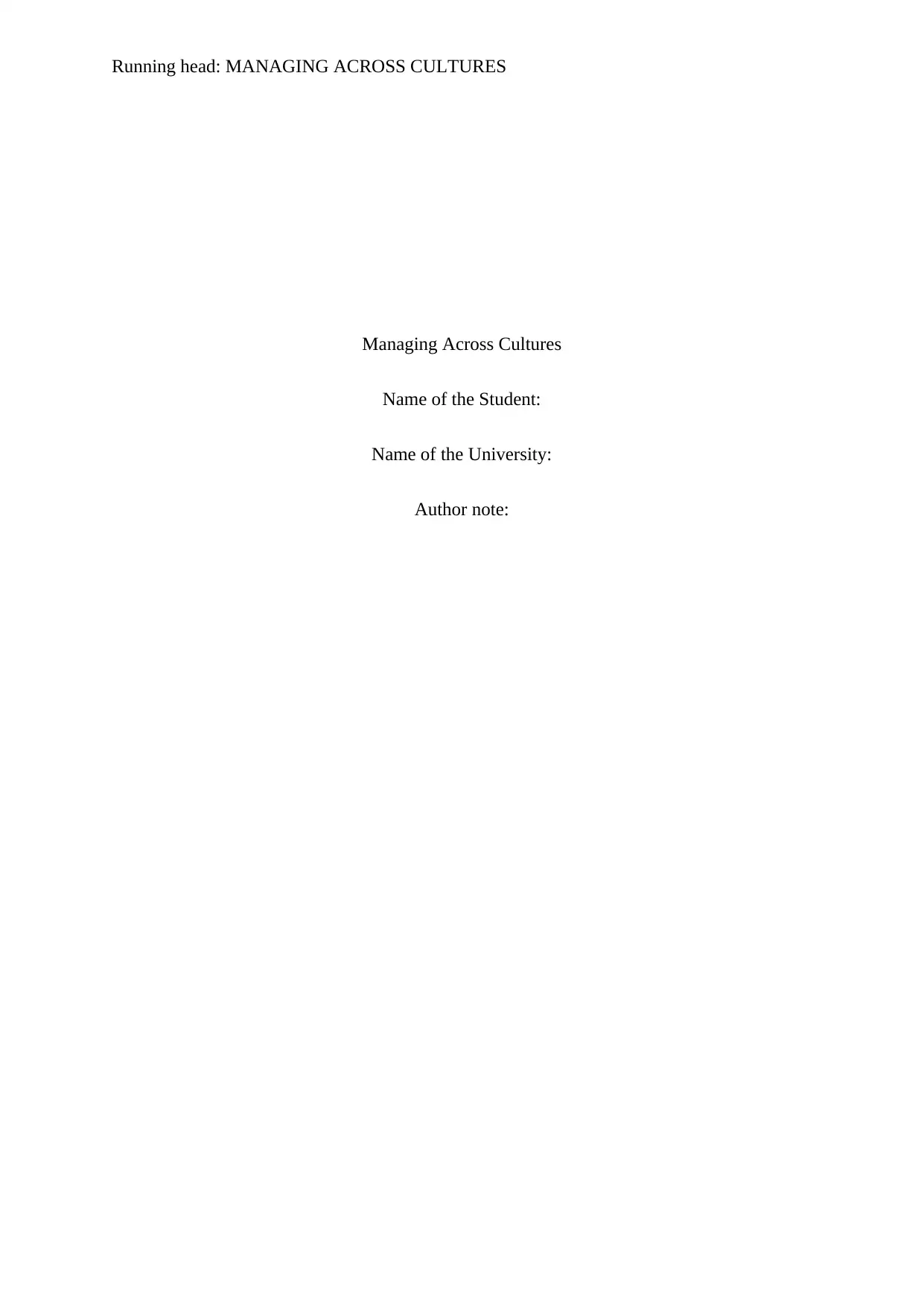
Running head: MANAGING ACROSS CULTURES
Managing Across Cultures
Name of the Student:
Name of the University:
Author note:
Managing Across Cultures
Name of the Student:
Name of the University:
Author note:
Paraphrase This Document
Need a fresh take? Get an instant paraphrase of this document with our AI Paraphraser
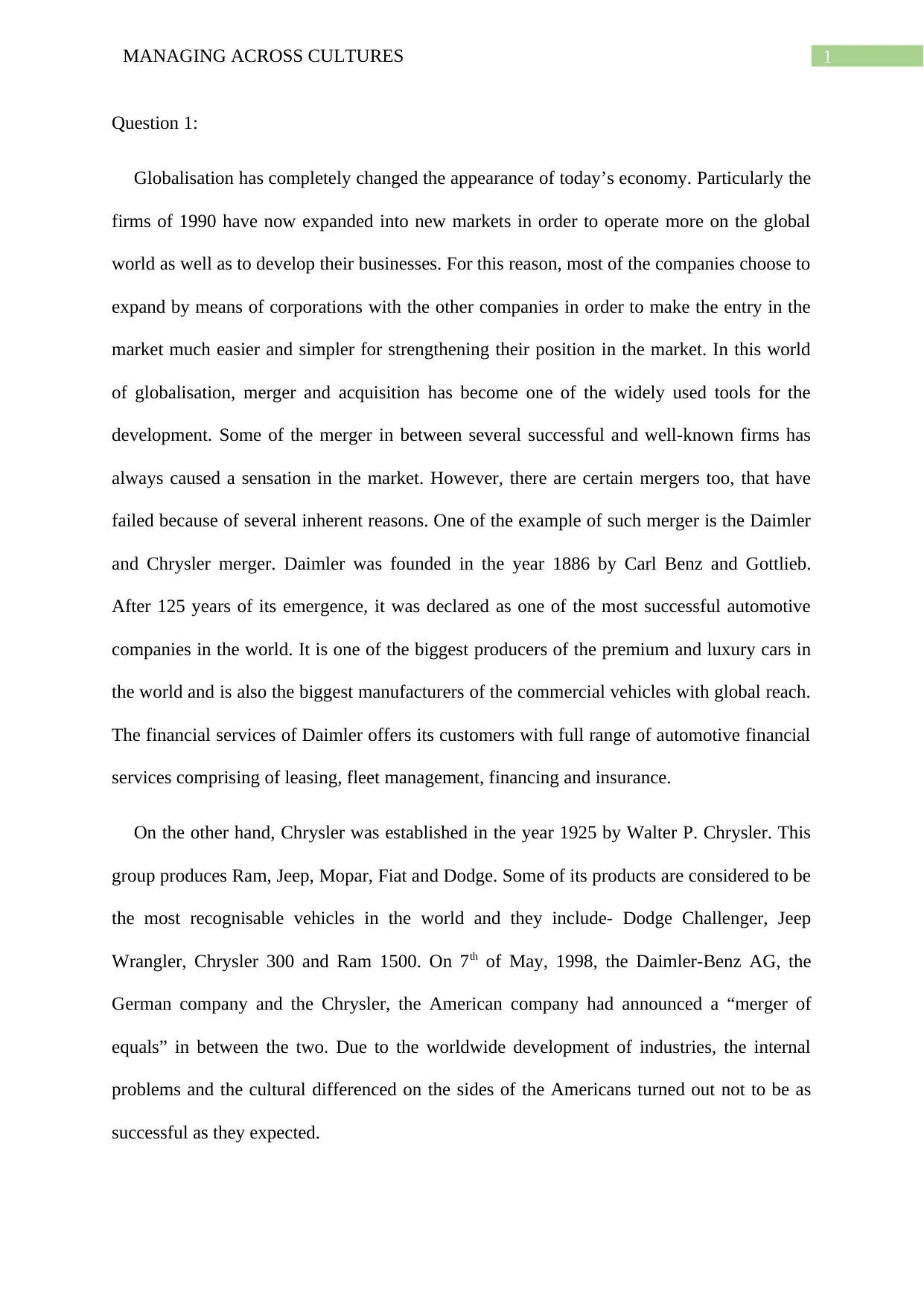
1MANAGING ACROSS CULTURES
Question 1:
Globalisation has completely changed the appearance of today’s economy. Particularly the
firms of 1990 have now expanded into new markets in order to operate more on the global
world as well as to develop their businesses. For this reason, most of the companies choose to
expand by means of corporations with the other companies in order to make the entry in the
market much easier and simpler for strengthening their position in the market. In this world
of globalisation, merger and acquisition has become one of the widely used tools for the
development. Some of the merger in between several successful and well-known firms has
always caused a sensation in the market. However, there are certain mergers too, that have
failed because of several inherent reasons. One of the example of such merger is the Daimler
and Chrysler merger. Daimler was founded in the year 1886 by Carl Benz and Gottlieb.
After 125 years of its emergence, it was declared as one of the most successful automotive
companies in the world. It is one of the biggest producers of the premium and luxury cars in
the world and is also the biggest manufacturers of the commercial vehicles with global reach.
The financial services of Daimler offers its customers with full range of automotive financial
services comprising of leasing, fleet management, financing and insurance.
On the other hand, Chrysler was established in the year 1925 by Walter P. Chrysler. This
group produces Ram, Jeep, Mopar, Fiat and Dodge. Some of its products are considered to be
the most recognisable vehicles in the world and they include- Dodge Challenger, Jeep
Wrangler, Chrysler 300 and Ram 1500. On 7th of May, 1998, the Daimler-Benz AG, the
German company and the Chrysler, the American company had announced a “merger of
equals” in between the two. Due to the worldwide development of industries, the internal
problems and the cultural differenced on the sides of the Americans turned out not to be as
successful as they expected.
Question 1:
Globalisation has completely changed the appearance of today’s economy. Particularly the
firms of 1990 have now expanded into new markets in order to operate more on the global
world as well as to develop their businesses. For this reason, most of the companies choose to
expand by means of corporations with the other companies in order to make the entry in the
market much easier and simpler for strengthening their position in the market. In this world
of globalisation, merger and acquisition has become one of the widely used tools for the
development. Some of the merger in between several successful and well-known firms has
always caused a sensation in the market. However, there are certain mergers too, that have
failed because of several inherent reasons. One of the example of such merger is the Daimler
and Chrysler merger. Daimler was founded in the year 1886 by Carl Benz and Gottlieb.
After 125 years of its emergence, it was declared as one of the most successful automotive
companies in the world. It is one of the biggest producers of the premium and luxury cars in
the world and is also the biggest manufacturers of the commercial vehicles with global reach.
The financial services of Daimler offers its customers with full range of automotive financial
services comprising of leasing, fleet management, financing and insurance.
On the other hand, Chrysler was established in the year 1925 by Walter P. Chrysler. This
group produces Ram, Jeep, Mopar, Fiat and Dodge. Some of its products are considered to be
the most recognisable vehicles in the world and they include- Dodge Challenger, Jeep
Wrangler, Chrysler 300 and Ram 1500. On 7th of May, 1998, the Daimler-Benz AG, the
German company and the Chrysler, the American company had announced a “merger of
equals” in between the two. Due to the worldwide development of industries, the internal
problems and the cultural differenced on the sides of the Americans turned out not to be as
successful as they expected.
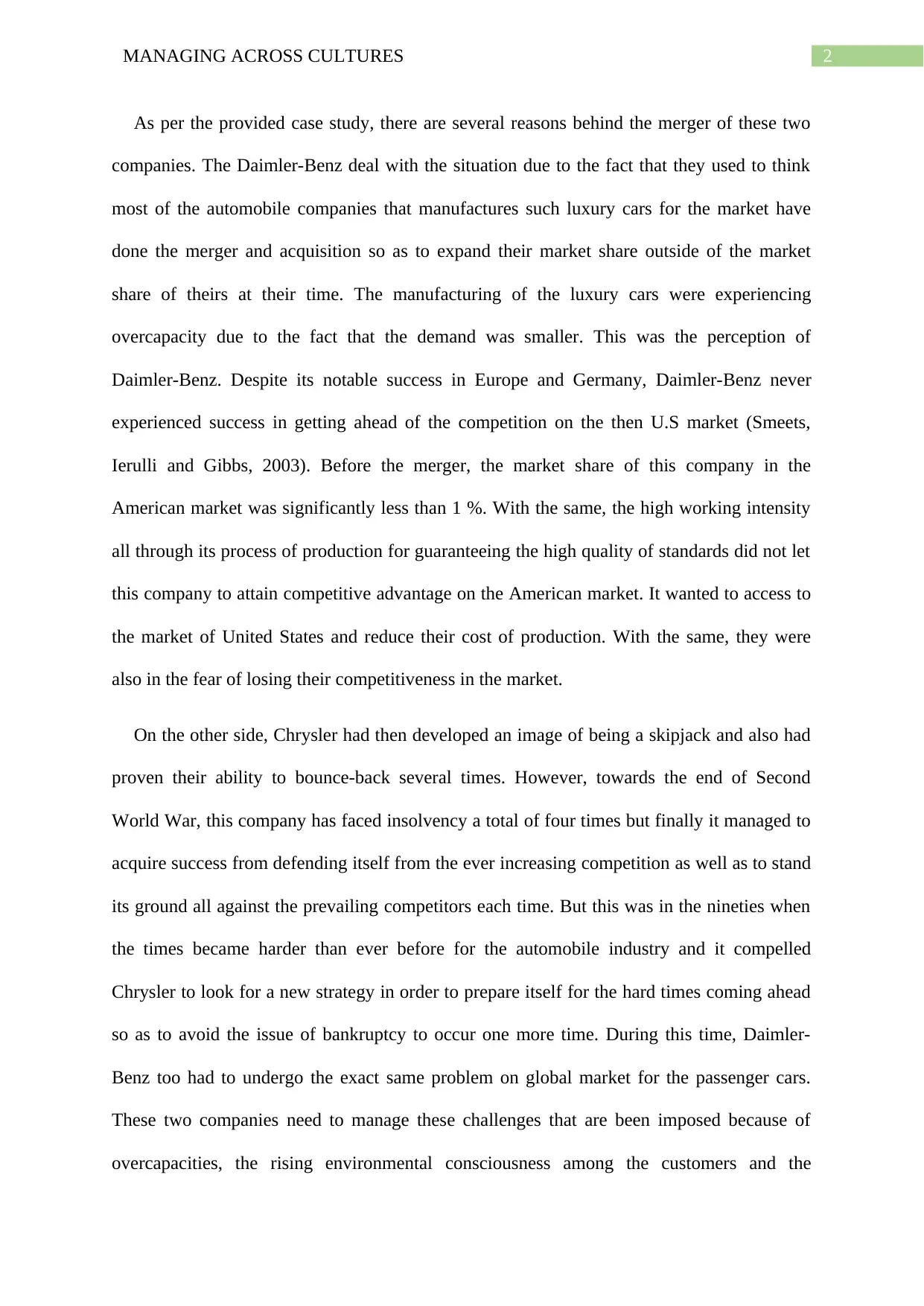
2MANAGING ACROSS CULTURES
As per the provided case study, there are several reasons behind the merger of these two
companies. The Daimler-Benz deal with the situation due to the fact that they used to think
most of the automobile companies that manufactures such luxury cars for the market have
done the merger and acquisition so as to expand their market share outside of the market
share of theirs at their time. The manufacturing of the luxury cars were experiencing
overcapacity due to the fact that the demand was smaller. This was the perception of
Daimler-Benz. Despite its notable success in Europe and Germany, Daimler-Benz never
experienced success in getting ahead of the competition on the then U.S market (Smeets,
Ierulli and Gibbs, 2003). Before the merger, the market share of this company in the
American market was significantly less than 1 %. With the same, the high working intensity
all through its process of production for guaranteeing the high quality of standards did not let
this company to attain competitive advantage on the American market. It wanted to access to
the market of United States and reduce their cost of production. With the same, they were
also in the fear of losing their competitiveness in the market.
On the other side, Chrysler had then developed an image of being a skipjack and also had
proven their ability to bounce-back several times. However, towards the end of Second
World War, this company has faced insolvency a total of four times but finally it managed to
acquire success from defending itself from the ever increasing competition as well as to stand
its ground all against the prevailing competitors each time. But this was in the nineties when
the times became harder than ever before for the automobile industry and it compelled
Chrysler to look for a new strategy in order to prepare itself for the hard times coming ahead
so as to avoid the issue of bankruptcy to occur one more time. During this time, Daimler-
Benz too had to undergo the exact same problem on global market for the passenger cars.
These two companies need to manage these challenges that are been imposed because of
overcapacities, the rising environmental consciousness among the customers and the
As per the provided case study, there are several reasons behind the merger of these two
companies. The Daimler-Benz deal with the situation due to the fact that they used to think
most of the automobile companies that manufactures such luxury cars for the market have
done the merger and acquisition so as to expand their market share outside of the market
share of theirs at their time. The manufacturing of the luxury cars were experiencing
overcapacity due to the fact that the demand was smaller. This was the perception of
Daimler-Benz. Despite its notable success in Europe and Germany, Daimler-Benz never
experienced success in getting ahead of the competition on the then U.S market (Smeets,
Ierulli and Gibbs, 2003). Before the merger, the market share of this company in the
American market was significantly less than 1 %. With the same, the high working intensity
all through its process of production for guaranteeing the high quality of standards did not let
this company to attain competitive advantage on the American market. It wanted to access to
the market of United States and reduce their cost of production. With the same, they were
also in the fear of losing their competitiveness in the market.
On the other side, Chrysler had then developed an image of being a skipjack and also had
proven their ability to bounce-back several times. However, towards the end of Second
World War, this company has faced insolvency a total of four times but finally it managed to
acquire success from defending itself from the ever increasing competition as well as to stand
its ground all against the prevailing competitors each time. But this was in the nineties when
the times became harder than ever before for the automobile industry and it compelled
Chrysler to look for a new strategy in order to prepare itself for the hard times coming ahead
so as to avoid the issue of bankruptcy to occur one more time. During this time, Daimler-
Benz too had to undergo the exact same problem on global market for the passenger cars.
These two companies need to manage these challenges that are been imposed because of
overcapacities, the rising environmental consciousness among the customers and the
⊘ This is a preview!⊘
Do you want full access?
Subscribe today to unlock all pages.

Trusted by 1+ million students worldwide
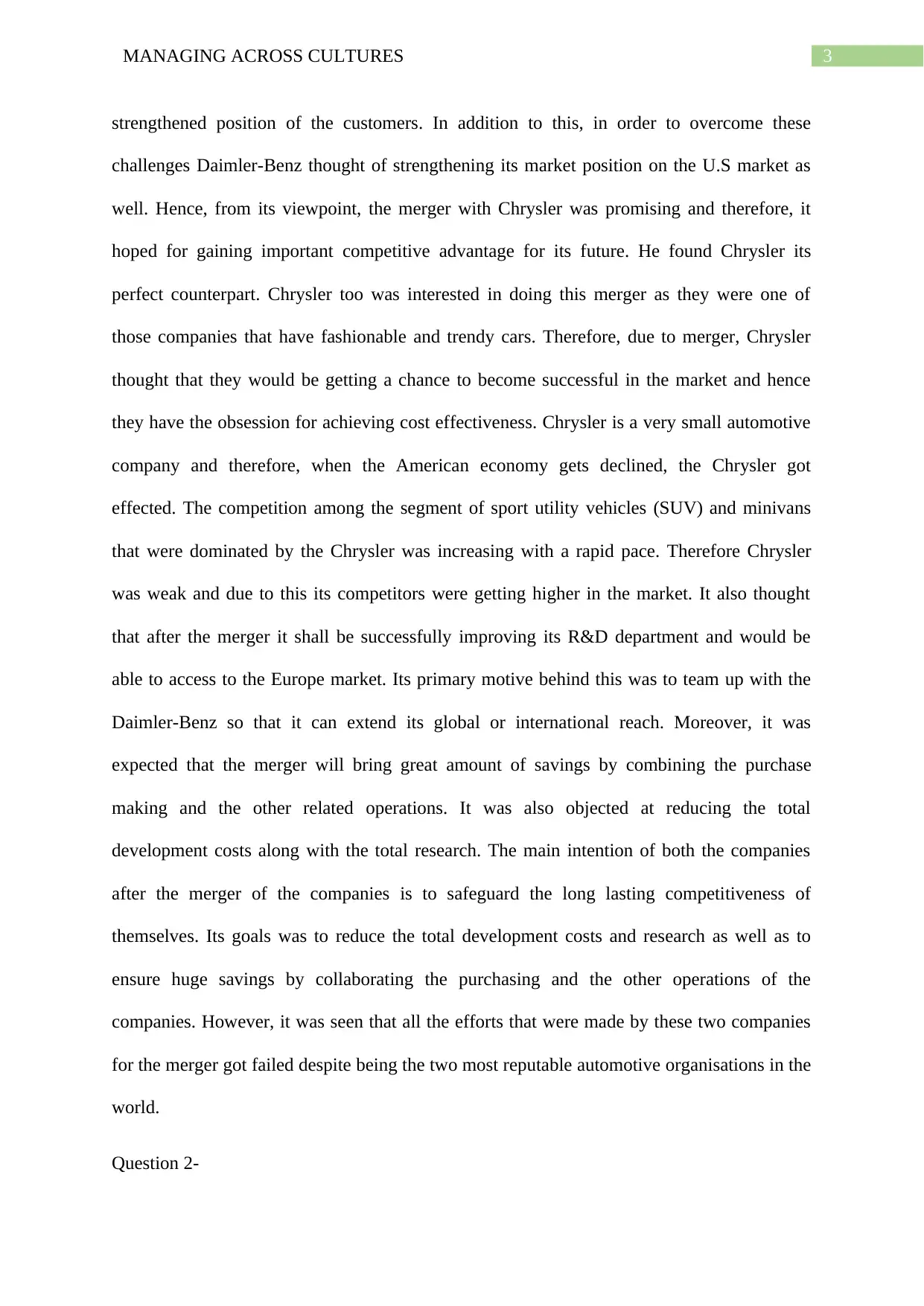
3MANAGING ACROSS CULTURES
strengthened position of the customers. In addition to this, in order to overcome these
challenges Daimler-Benz thought of strengthening its market position on the U.S market as
well. Hence, from its viewpoint, the merger with Chrysler was promising and therefore, it
hoped for gaining important competitive advantage for its future. He found Chrysler its
perfect counterpart. Chrysler too was interested in doing this merger as they were one of
those companies that have fashionable and trendy cars. Therefore, due to merger, Chrysler
thought that they would be getting a chance to become successful in the market and hence
they have the obsession for achieving cost effectiveness. Chrysler is a very small automotive
company and therefore, when the American economy gets declined, the Chrysler got
effected. The competition among the segment of sport utility vehicles (SUV) and minivans
that were dominated by the Chrysler was increasing with a rapid pace. Therefore Chrysler
was weak and due to this its competitors were getting higher in the market. It also thought
that after the merger it shall be successfully improving its R&D department and would be
able to access to the Europe market. Its primary motive behind this was to team up with the
Daimler-Benz so that it can extend its global or international reach. Moreover, it was
expected that the merger will bring great amount of savings by combining the purchase
making and the other related operations. It was also objected at reducing the total
development costs along with the total research. The main intention of both the companies
after the merger of the companies is to safeguard the long lasting competitiveness of
themselves. Its goals was to reduce the total development costs and research as well as to
ensure huge savings by collaborating the purchasing and the other operations of the
companies. However, it was seen that all the efforts that were made by these two companies
for the merger got failed despite being the two most reputable automotive organisations in the
world.
Question 2-
strengthened position of the customers. In addition to this, in order to overcome these
challenges Daimler-Benz thought of strengthening its market position on the U.S market as
well. Hence, from its viewpoint, the merger with Chrysler was promising and therefore, it
hoped for gaining important competitive advantage for its future. He found Chrysler its
perfect counterpart. Chrysler too was interested in doing this merger as they were one of
those companies that have fashionable and trendy cars. Therefore, due to merger, Chrysler
thought that they would be getting a chance to become successful in the market and hence
they have the obsession for achieving cost effectiveness. Chrysler is a very small automotive
company and therefore, when the American economy gets declined, the Chrysler got
effected. The competition among the segment of sport utility vehicles (SUV) and minivans
that were dominated by the Chrysler was increasing with a rapid pace. Therefore Chrysler
was weak and due to this its competitors were getting higher in the market. It also thought
that after the merger it shall be successfully improving its R&D department and would be
able to access to the Europe market. Its primary motive behind this was to team up with the
Daimler-Benz so that it can extend its global or international reach. Moreover, it was
expected that the merger will bring great amount of savings by combining the purchase
making and the other related operations. It was also objected at reducing the total
development costs along with the total research. The main intention of both the companies
after the merger of the companies is to safeguard the long lasting competitiveness of
themselves. Its goals was to reduce the total development costs and research as well as to
ensure huge savings by collaborating the purchasing and the other operations of the
companies. However, it was seen that all the efforts that were made by these two companies
for the merger got failed despite being the two most reputable automotive organisations in the
world.
Question 2-
Paraphrase This Document
Need a fresh take? Get an instant paraphrase of this document with our AI Paraphraser
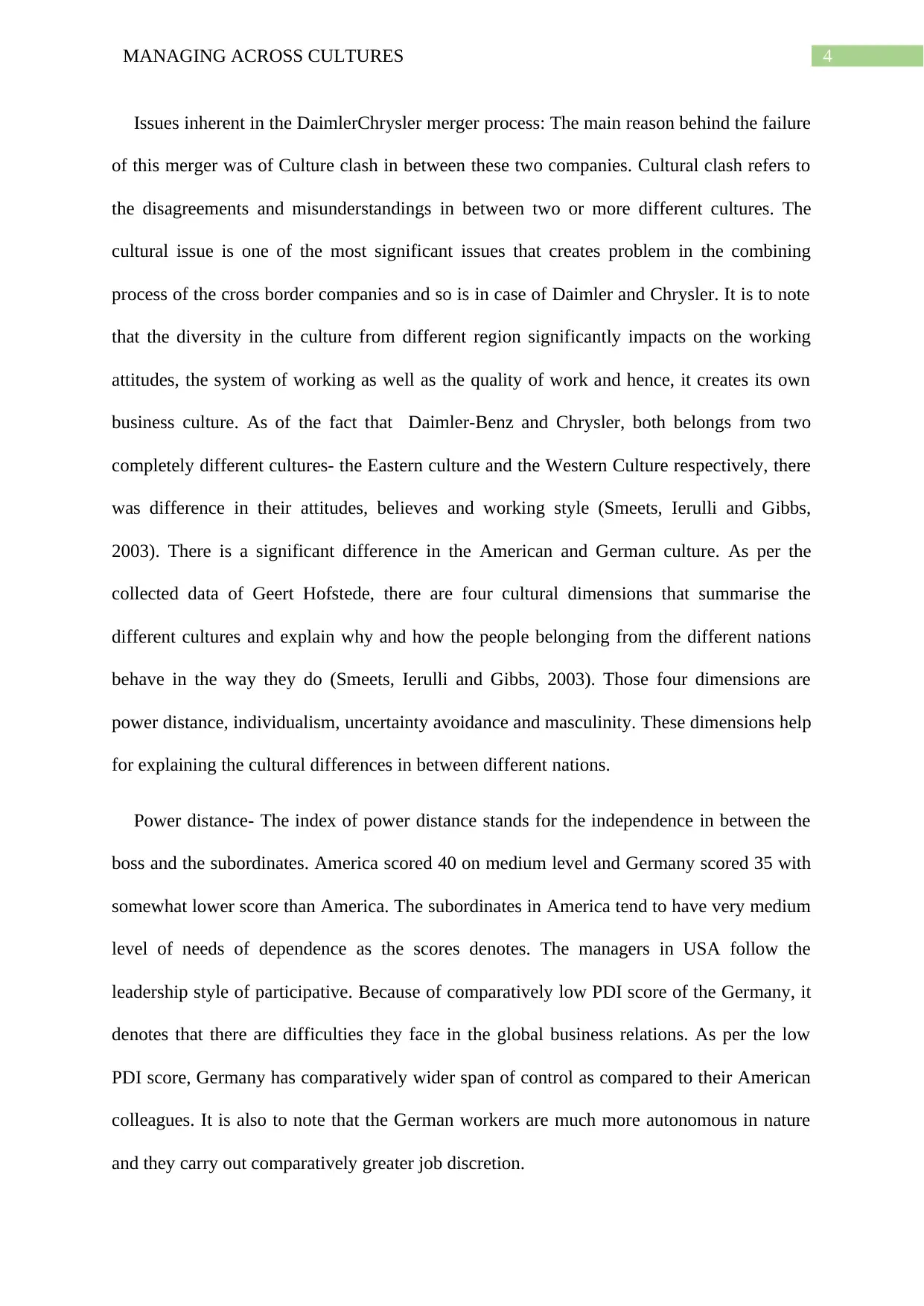
4MANAGING ACROSS CULTURES
Issues inherent in the DaimlerChrysler merger process: The main reason behind the failure
of this merger was of Culture clash in between these two companies. Cultural clash refers to
the disagreements and misunderstandings in between two or more different cultures. The
cultural issue is one of the most significant issues that creates problem in the combining
process of the cross border companies and so is in case of Daimler and Chrysler. It is to note
that the diversity in the culture from different region significantly impacts on the working
attitudes, the system of working as well as the quality of work and hence, it creates its own
business culture. As of the fact that Daimler-Benz and Chrysler, both belongs from two
completely different cultures- the Eastern culture and the Western Culture respectively, there
was difference in their attitudes, believes and working style (Smeets, Ierulli and Gibbs,
2003). There is a significant difference in the American and German culture. As per the
collected data of Geert Hofstede, there are four cultural dimensions that summarise the
different cultures and explain why and how the people belonging from the different nations
behave in the way they do (Smeets, Ierulli and Gibbs, 2003). Those four dimensions are
power distance, individualism, uncertainty avoidance and masculinity. These dimensions help
for explaining the cultural differences in between different nations.
Power distance- The index of power distance stands for the independence in between the
boss and the subordinates. America scored 40 on medium level and Germany scored 35 with
somewhat lower score than America. The subordinates in America tend to have very medium
level of needs of dependence as the scores denotes. The managers in USA follow the
leadership style of participative. Because of comparatively low PDI score of the Germany, it
denotes that there are difficulties they face in the global business relations. As per the low
PDI score, Germany has comparatively wider span of control as compared to their American
colleagues. It is also to note that the German workers are much more autonomous in nature
and they carry out comparatively greater job discretion.
Issues inherent in the DaimlerChrysler merger process: The main reason behind the failure
of this merger was of Culture clash in between these two companies. Cultural clash refers to
the disagreements and misunderstandings in between two or more different cultures. The
cultural issue is one of the most significant issues that creates problem in the combining
process of the cross border companies and so is in case of Daimler and Chrysler. It is to note
that the diversity in the culture from different region significantly impacts on the working
attitudes, the system of working as well as the quality of work and hence, it creates its own
business culture. As of the fact that Daimler-Benz and Chrysler, both belongs from two
completely different cultures- the Eastern culture and the Western Culture respectively, there
was difference in their attitudes, believes and working style (Smeets, Ierulli and Gibbs,
2003). There is a significant difference in the American and German culture. As per the
collected data of Geert Hofstede, there are four cultural dimensions that summarise the
different cultures and explain why and how the people belonging from the different nations
behave in the way they do (Smeets, Ierulli and Gibbs, 2003). Those four dimensions are
power distance, individualism, uncertainty avoidance and masculinity. These dimensions help
for explaining the cultural differences in between different nations.
Power distance- The index of power distance stands for the independence in between the
boss and the subordinates. America scored 40 on medium level and Germany scored 35 with
somewhat lower score than America. The subordinates in America tend to have very medium
level of needs of dependence as the scores denotes. The managers in USA follow the
leadership style of participative. Because of comparatively low PDI score of the Germany, it
denotes that there are difficulties they face in the global business relations. As per the low
PDI score, Germany has comparatively wider span of control as compared to their American
colleagues. It is also to note that the German workers are much more autonomous in nature
and they carry out comparatively greater job discretion.
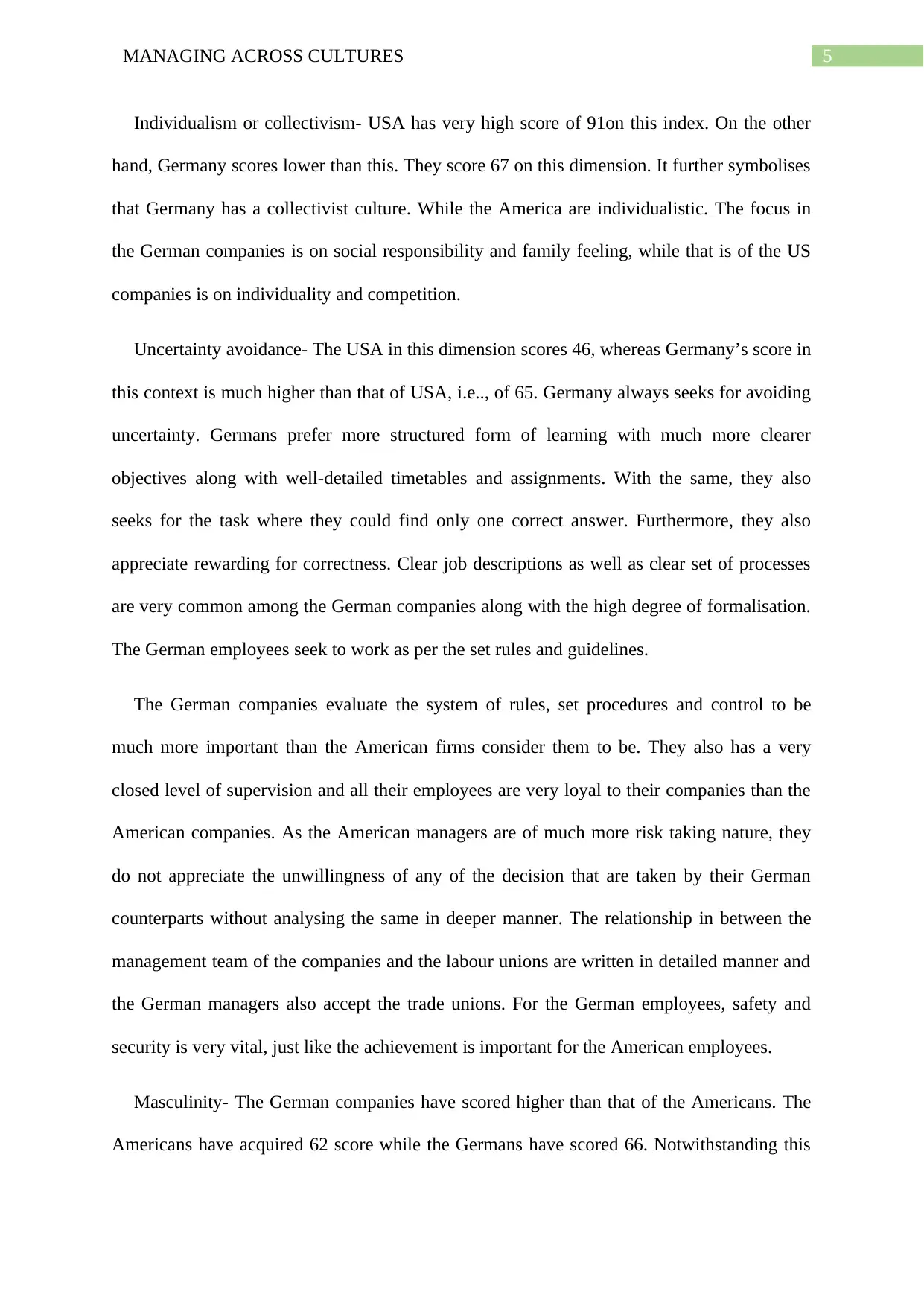
5MANAGING ACROSS CULTURES
Individualism or collectivism- USA has very high score of 91on this index. On the other
hand, Germany scores lower than this. They score 67 on this dimension. It further symbolises
that Germany has a collectivist culture. While the America are individualistic. The focus in
the German companies is on social responsibility and family feeling, while that is of the US
companies is on individuality and competition.
Uncertainty avoidance- The USA in this dimension scores 46, whereas Germany’s score in
this context is much higher than that of USA, i.e.., of 65. Germany always seeks for avoiding
uncertainty. Germans prefer more structured form of learning with much more clearer
objectives along with well-detailed timetables and assignments. With the same, they also
seeks for the task where they could find only one correct answer. Furthermore, they also
appreciate rewarding for correctness. Clear job descriptions as well as clear set of processes
are very common among the German companies along with the high degree of formalisation.
The German employees seek to work as per the set rules and guidelines.
The German companies evaluate the system of rules, set procedures and control to be
much more important than the American firms consider them to be. They also has a very
closed level of supervision and all their employees are very loyal to their companies than the
American companies. As the American managers are of much more risk taking nature, they
do not appreciate the unwillingness of any of the decision that are taken by their German
counterparts without analysing the same in deeper manner. The relationship in between the
management team of the companies and the labour unions are written in detailed manner and
the German managers also accept the trade unions. For the German employees, safety and
security is very vital, just like the achievement is important for the American employees.
Masculinity- The German companies have scored higher than that of the Americans. The
Americans have acquired 62 score while the Germans have scored 66. Notwithstanding this
Individualism or collectivism- USA has very high score of 91on this index. On the other
hand, Germany scores lower than this. They score 67 on this dimension. It further symbolises
that Germany has a collectivist culture. While the America are individualistic. The focus in
the German companies is on social responsibility and family feeling, while that is of the US
companies is on individuality and competition.
Uncertainty avoidance- The USA in this dimension scores 46, whereas Germany’s score in
this context is much higher than that of USA, i.e.., of 65. Germany always seeks for avoiding
uncertainty. Germans prefer more structured form of learning with much more clearer
objectives along with well-detailed timetables and assignments. With the same, they also
seeks for the task where they could find only one correct answer. Furthermore, they also
appreciate rewarding for correctness. Clear job descriptions as well as clear set of processes
are very common among the German companies along with the high degree of formalisation.
The German employees seek to work as per the set rules and guidelines.
The German companies evaluate the system of rules, set procedures and control to be
much more important than the American firms consider them to be. They also has a very
closed level of supervision and all their employees are very loyal to their companies than the
American companies. As the American managers are of much more risk taking nature, they
do not appreciate the unwillingness of any of the decision that are taken by their German
counterparts without analysing the same in deeper manner. The relationship in between the
management team of the companies and the labour unions are written in detailed manner and
the German managers also accept the trade unions. For the German employees, safety and
security is very vital, just like the achievement is important for the American employees.
Masculinity- The German companies have scored higher than that of the Americans. The
Americans have acquired 62 score while the Germans have scored 66. Notwithstanding this
⊘ This is a preview!⊘
Do you want full access?
Subscribe today to unlock all pages.

Trusted by 1+ million students worldwide
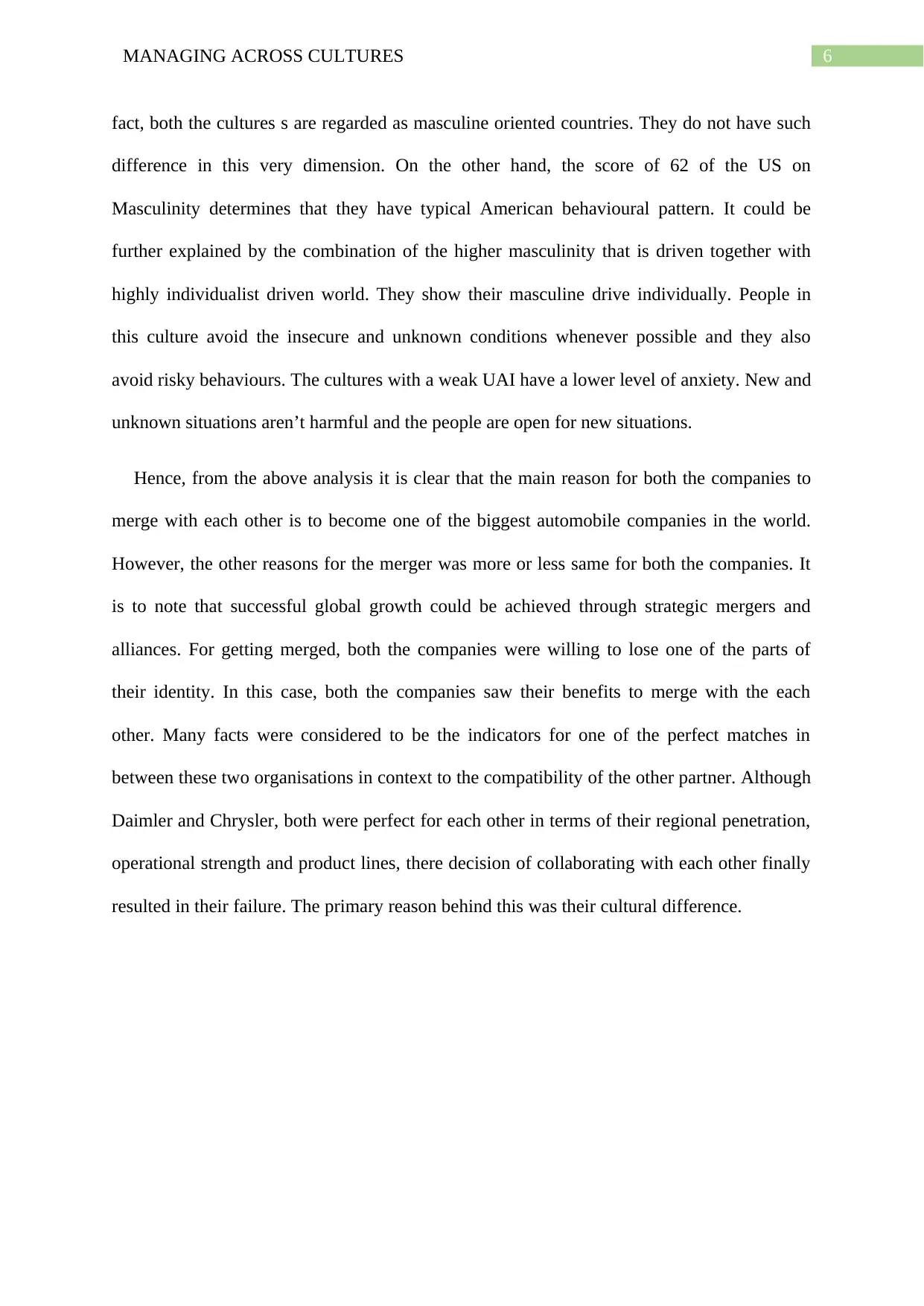
6MANAGING ACROSS CULTURES
fact, both the cultures s are regarded as masculine oriented countries. They do not have such
difference in this very dimension. On the other hand, the score of 62 of the US on
Masculinity determines that they have typical American behavioural pattern. It could be
further explained by the combination of the higher masculinity that is driven together with
highly individualist driven world. They show their masculine drive individually. People in
this culture avoid the insecure and unknown conditions whenever possible and they also
avoid risky behaviours. The cultures with a weak UAI have a lower level of anxiety. New and
unknown situations aren’t harmful and the people are open for new situations.
Hence, from the above analysis it is clear that the main reason for both the companies to
merge with each other is to become one of the biggest automobile companies in the world.
However, the other reasons for the merger was more or less same for both the companies. It
is to note that successful global growth could be achieved through strategic mergers and
alliances. For getting merged, both the companies were willing to lose one of the parts of
their identity. In this case, both the companies saw their benefits to merge with the each
other. Many facts were considered to be the indicators for one of the perfect matches in
between these two organisations in context to the compatibility of the other partner. Although
Daimler and Chrysler, both were perfect for each other in terms of their regional penetration,
operational strength and product lines, there decision of collaborating with each other finally
resulted in their failure. The primary reason behind this was their cultural difference.
fact, both the cultures s are regarded as masculine oriented countries. They do not have such
difference in this very dimension. On the other hand, the score of 62 of the US on
Masculinity determines that they have typical American behavioural pattern. It could be
further explained by the combination of the higher masculinity that is driven together with
highly individualist driven world. They show their masculine drive individually. People in
this culture avoid the insecure and unknown conditions whenever possible and they also
avoid risky behaviours. The cultures with a weak UAI have a lower level of anxiety. New and
unknown situations aren’t harmful and the people are open for new situations.
Hence, from the above analysis it is clear that the main reason for both the companies to
merge with each other is to become one of the biggest automobile companies in the world.
However, the other reasons for the merger was more or less same for both the companies. It
is to note that successful global growth could be achieved through strategic mergers and
alliances. For getting merged, both the companies were willing to lose one of the parts of
their identity. In this case, both the companies saw their benefits to merge with the each
other. Many facts were considered to be the indicators for one of the perfect matches in
between these two organisations in context to the compatibility of the other partner. Although
Daimler and Chrysler, both were perfect for each other in terms of their regional penetration,
operational strength and product lines, there decision of collaborating with each other finally
resulted in their failure. The primary reason behind this was their cultural difference.
Paraphrase This Document
Need a fresh take? Get an instant paraphrase of this document with our AI Paraphraser
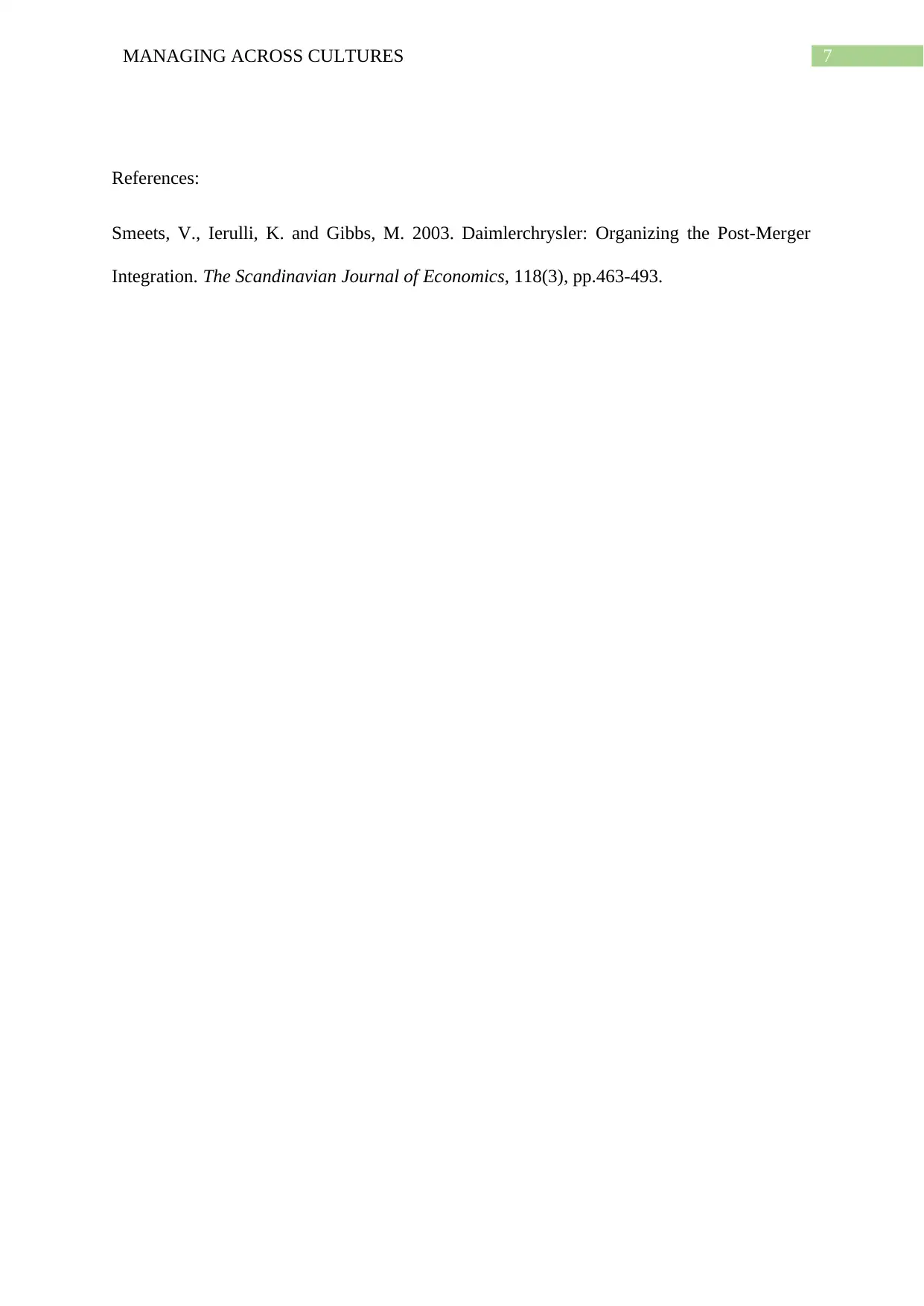
7MANAGING ACROSS CULTURES
References:
Smeets, V., Ierulli, K. and Gibbs, M. 2003. Daimlerchrysler: Organizing the Post-Merger
Integration. The Scandinavian Journal of Economics, 118(3), pp.463-493.
References:
Smeets, V., Ierulli, K. and Gibbs, M. 2003. Daimlerchrysler: Organizing the Post-Merger
Integration. The Scandinavian Journal of Economics, 118(3), pp.463-493.
1 out of 8
Related Documents
Your All-in-One AI-Powered Toolkit for Academic Success.
+13062052269
info@desklib.com
Available 24*7 on WhatsApp / Email
![[object Object]](/_next/static/media/star-bottom.7253800d.svg)
Unlock your academic potential
Copyright © 2020–2025 A2Z Services. All Rights Reserved. Developed and managed by ZUCOL.





